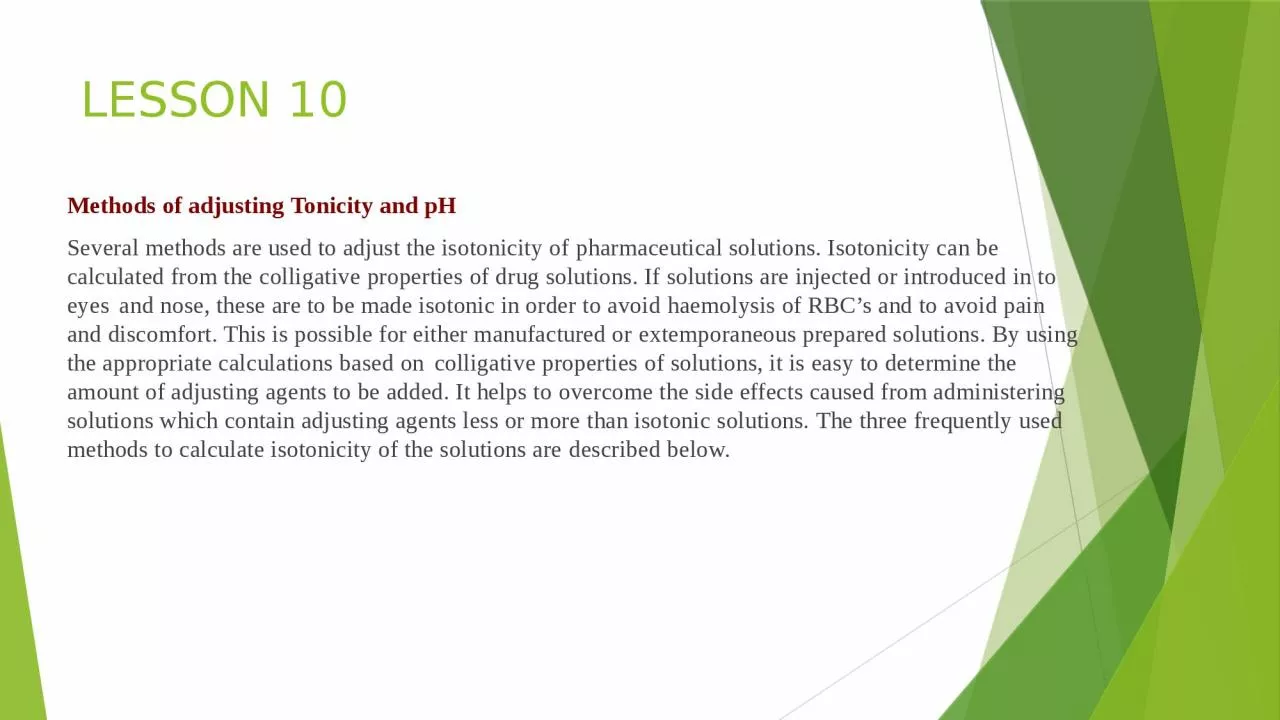

adjusting Tonicity and pH Several methods are used to adjust the isotonicity of pharmaceutical solutions Isotonicity can be calculated from the colligative properties ID: 929277
Download Presentation The PPT/PDF document "LESSON 10 Methods of" is the property of its rightful owner. Permission is granted to download and print the materials on this web site for personal, non-commercial use only, and to display it on your personal computer provided you do not modify the materials and that you retain all copyright notices contained in the materials. By downloading content from our website, you accept the terms of this agreement.
Slide1
LESSON 10
Methods
of
adjusting
Tonicity
and
pH
Several methods are used to adjust the isotonicity of
pharmaceutical solutions. Isotonicity can be calculated
from the
colligative
properties
of
drug solutions. If
solutions
are
injected
or
introduced
in
to
eyes
and
nose, these are to be made isotonic in order to avoid
haemolysis
of
RBC’s
and
to
avoid
pain
and
discomfort. This is possible for either manufactured or
extemporaneous
prepared
solutions.
By
using
the
appropriate
calculations
based
on
colligative
properties
of
solutions,
it
is
easy
to
determine
the
amount of adjusting agents to be added. It helps to
overcome the side effects caused from administering
solutions which contain adjusting agents less or more
than
isotonic
solutions.
The
three
frequently
used
methods to calculate isotonicity of the solutions are
described
below.
Slide2Class-1 Methods:
Nacl
or some other substances is
added to the solution of the drug to lower the freezing
point
of the
solution to
-0.52ᵒC and thus
make
the
solution isotonic.
Examples
of
this class-
Cryoscopic
method
Sodium
chloride
equivalent
method.
Class-2 Methods:
Water is added to the drug in a
sufficient
amount
to
make
it
isotonic.
Then
the
preparation
is
brought
to
its
final
volume
with
an
isotonic
or
buffered
isotonic solution.
Slide3Class I Methods:
Cryoscopic
method-
Isotonic solutions may be made in terms of data relating to colligative properties of solutions. Colligative properties include osmotic pressure, elevation in boiling point, depression in freezing point, and lowering of
vapour
pressure. Depression in freezing point is a colligative property which is practical and most convenient for adjusting tonicity. The freezing point of human blood and lacrimal fluids is – 0.52°C. This temperature corresponds to freezing point of 0.90% (w/v) sodium chloride solution. This is considered to be isotonic to blood and lacrimal fluids. The freezing point depression of 1% (w/v) sodium chloride (∆Tf1%) is 0.58°C. In this method, an amount of tonicity adjuster (e.g. sodium chloride) is added to drug solution such that the final freezing point lowering is that of blood or serum (0.52°C).
Slide4Sodium chloride equivalent method-
This method is based on calculating the E-value, i.e. the sodium chloride equivalent or tonicity equivalent of a drug. It is the amount of sodium chloride that has the same osmotic effect (i.e. is equivalent to) as 1 g of the drug.
Derivation of E-value:
Since freezing point depression is a colligative property, it depends on the number of particles, dissociation and association of particles.
Therefore, the equation ∆
T
f
=
K
f
C
can be replaced with ∆
T
f
=
L
iso
C
where, ∆T is the depression in freezing point,
Kf
is the freezing point depression constant, c is the concentration.
Liso
is a factor that is equal to
iKf
, where
i
is the
vant
Hoff factor.
L
iso
= ∆
T
f
/ C
Slide5Class II Methods:
White–Vincent method-
The Class II methods of computing tonicity involve the addition of water to the drugs to prepare an isotonic solution, followed by the addition of an isotonic or isotonic-buffered diluting vehicle to make up the solution up to the final volume. White and Vincent developed a simplified method for performing such calculations. The equation is derived as shown below:
To prepare 30 mL of a 1% (w/v) solution of procaine hydrochloride isotonic with body fluid (=0.3 g), weight of the drug w is multiplied by the sodium chloride equivalent E.
Slide6This is the quantity of sodium chloride osmotically equivalent to 0.3 g of procaine hydrochloride
= weight of drug (g) × E of drug (1)
= 0.3 × 0.21 = 0.063 g
It is known that 0.9 g of sodium chloride when dissolved in sufficient water sufficient to make a final volume of 100 mL yields an isotonic solution. The volume V of isotonic solution that can be prepared from 0.063 g of sodium chloride (equivalent to 0.3 g of procaine hydrochloride) is obtained by solving the following proportion:
0.9g / 100ml = 0.063g / V
Slide7V = 0.063 X 100 / 0.9 = 7.0ml (2)
Accordingly, Eq. (2) can be written as
V = w × E × 111.1 (3)
where V is the volume of isotonic solution (in mL) that may be prepared by mixing the drug with water, w the weight of the drug (in grams) and E the sodium chloride equivalent of the drug. The constant, 111.1, represents the volume of isotonic solution in
millilitres
obtained by dissolving 1 g of sodium chloride in water.
The isotonic and isotonic-buffered diluting solutions all have isotonicity values of 0.9% NaCl.
Slide8Sprowls
method-
A further simplification of the method of White and Vincent was prepared by
Sprowls
. He recognized that the Eq. (3) given by White and Vincent could be utilized to make a table of values of V when the weight of the drug w was arbitrarily fixed.
Sprowls
chose 0.3 g as the weight of drug, the quantity for one fluid ounce of a 1% solution. The volume V of isotonic solution that can be prepared by mixing 0.3 g of a drug with sufficient water may be computed for drugs commonly formulate as ophthalmic and parenteral solutions.
The quantity of isotonic solution is finally brought to the specific volume with the desired isotonic or isotonic-buffered diluting solutions.